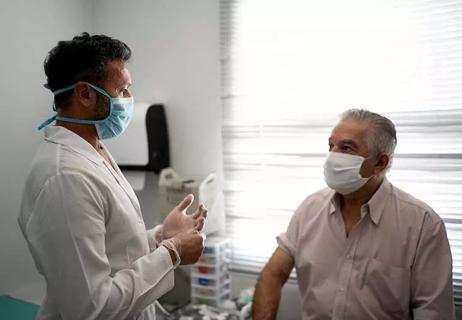Anyone with a prostate can get prostate cancer, but some symptoms could be masked

You probably don’t spend a lot of time thinking about your prostate. After all, it’s located inside of your body, out of sight (just below your bladder and in front of your rectum, to be specific). But prostate cancer is one of the most common types of cancer — so it may be time to start giving it some thought.
Advertisement
Cleveland Clinic is a non-profit academic medical center. Advertising on our site helps support our mission. We do not endorse non-Cleveland Clinic products or services. Policy
Frustratingly, many conversations about prostate health are only targeted at cisgender men (people whose gender identity corresponds with what they were assigned at birth). But if you’re a transgender woman or a nonbinary person assigned male at birth, you have a prostate, too, so you need to know all about prostate health and what symptoms to be on the lookout for.
LGBTQIA+ health specialist Henry Ng, MD, shares what you need to know about prostate cancer, including warning signs and when to get screened.
Yes. Anyone who has a prostate, including transgender women and nonbinary people assigned male at birth, can get prostate cancer. Even if you’ve had some type of gender-affirming genital surgery (sometimes, known as bottom surgery), you still likely have a prostate.
“There are various types of gender-affirming genital surgeries, but generally, the prostate isn’t removed during any of them,” Dr. Ng explains. “Because of the prostate’s location and its proximity to the bladder, removing it could be a threat to continence and bladder function.”
Most of the current research into prostate cancer was done on cisgender men, so most of the current statistics about prostate cancer are focused on that population. The U.S. Centers for Disease Control and Prevention (CDC) reports that about 13% of American men will get prostate cancer during their lifetime.
Advertisement
The statistics may or may not be the same for trans women.
“A lot of people who work in transgender health think that trans women are probably at lower risk to develop prostate cancer, in part because of hormonal changes like lower testosterone,” Dr. Ng says. “But we don’t know that for sure, and there are case reports and studies around prostate cancer in trans women, so we know prostate cancer does occur.”
Trans women who participated in a 2010 study were found to have lower levels of prostate-specific antigen (PSA, a protein made by the prostate) than cisgender men; high PSA levels can be an indicator of prostate cancer. But it’s important to note that all women in the study had an orchiectomy (testicular removal surgery) and low levels of testosterone, and most were on estrogen replacement therapy.
In general, the risk of prostate cancer increases as you get older, with about 60% of prostate cancers occurring over age 65. Most of the reported cases of prostate cancer in trans women have been in women who started gender-affirming hormone therapy after age 50 — but because prostate cancer often grows very slowly, the study notes that their tumors might’ve gone undiagnosed before they started hormones.
“To our knowledge, the symptoms of prostate cancer aren’t very different between transgender people and cisgender people,” Dr. Ng says. “For the most part, everyone who has a prostate can have the same types of symptoms.”
Symptoms of prostate cancer may include:
But there are a few other symptoms of prostate cancer that you might not experience or notice.
Some possible symptoms of prostate cancer could be different or nonexistent for trans women, depending on whether you’ve had gender-affirming genital surgery and if you’re on hormones.
If you haven’t had gender-affirming genital surgery and aren’t on gender-affirming hormones, you could experience symptoms like:
But what if you haven’t had gender-affirming genital surgery and you are on hormones? “These symptoms may be masked or be things that are not possible for you anymore,” Dr. Ng states.
That’s because gender-affirming hormones are known to cause changes in sexual function.
Advertisement
“When your testosterone levels are lower, you can typically still experience orgasms and pleasure, but erection function changes,” Dr. Ng explains. “This is an expected change for many people who are on gender-affirming hormonal therapy, but it could mask some symptoms of prostate cancer.”
If you’ve had some type of gender-affirming genital surgery, symptoms like erectile dysfunction and painful ejaculation inherently won’t apply to you. But there are other things you need to know — namely that after surgery, it can take a little bit of time for your body to restore normal urinary function.
“It takes a while for those tissues and muscles to reacclimate,” Dr. Ng says. “You might have some changes in urination for a while, like a change in your urine stream — but that’s not a problem with your prostate. It’s just your body finding a new normal during the post-operative period.”
But once your body has reacclimated, be aware of any new or concerning changes, like blood in your urine. It’s not necessarily a sign of prostate cancer (it could also be a urinary tract infection or a bladder issue), but you’ll want to ask your healthcare provider about it.
The symptoms of prostate cancer are thought to be less frequent in trans women — but that’s not necessarily because they don’t happen.
Advertisement
“We don’t know if that’s because we’re not diagnosing it in trans women,” Dr. Ng concedes. “There can be issues related to getting care, trusting the system and having those types of conversations with healthcare providers.”
It’s not always easy to find a healthcare provider you click with, and that can be especially true for members of the LGBTQIA+ community. But finding a provider who’s welcoming and affirming can help you feel more comfortable talking about your body and health.
Right now, there aren’t any trans-specific screening guidelines for prostate cancer. But the American Urological Association’s most recent guidelines apply to all “people for whom prostate cancer screening would be appropriate.”
According to those guidelines, you should have a prostate cancer screening every two to four years starting at age 50. Screenings typically stop after age 70 or 75. But ask your healthcare provider about being screened sooner if you know you’re at a higher risk for prostate cancer, like if you have:
“If have a prostate, you are at risk for prostate-related health issues,” Dr. Ng reiterates. “It’s important to be aware of your body and any possible symptoms.”
Advertisement
Learn more about our editorial process.
Advertisement

Family history and genetics may heighten your risk for prostate cancer

Check-in with your care team, and focus on low-impact exercises and walking for good gains

Sex may be different after prostate cancer treatment, but it can still be enjoyable

This simple blood test can be key to early detection

If this common cancer is caught early, the prognosis is good

An enlarged prostate, diuretics and bladder irritants can all contribute

Not following recommended follow-ups could put you at risk

Not following recommended follow-ups could put you at risk

Type 2 diabetes isn’t inevitable with these dietary changes

Applying a hot or cold compress can help with pain